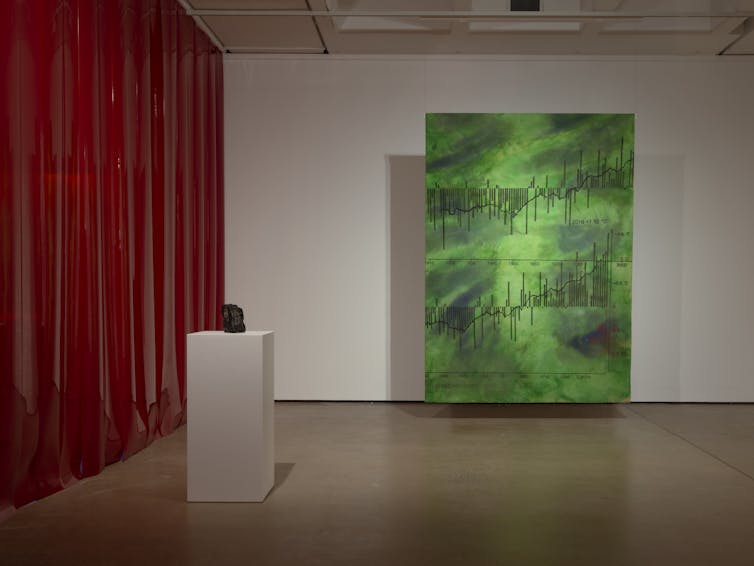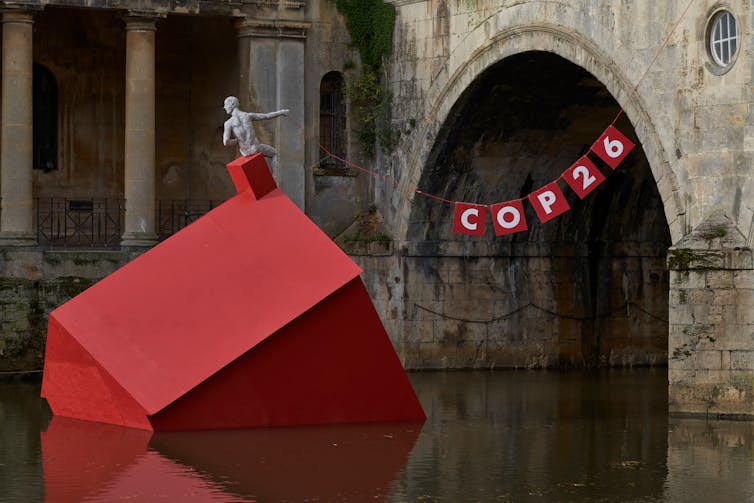Source: The Conversation (Au and NZ) – By Christiaan De Beukelaer, Senior Lecturer, The University of Melbourne
At COP26 in Glasgow, a public artwork intervention stands at Govan Graving Docks, directly opposite the main delegate zone. Still/Moving’s unmissable NO NEW WORLDS is a text and light-based piece that alternates between nine iterations of the three words in its title.
As artist Leonie Hampton explains, the re-writable quality of NO NEW WORLDS
embodies the idea that if we want to change the future, we need to address the stories we tell ourselves about our past, present and future.
This artwork echoes and responds to David Buckland’s powerful Cape Farewell project, done for the Paris COP21 in 2015, in which “Another World is Possible” was projected onto a melting iceberg.
It perfectly sums up the tensions playing out between broader society and the world leaders visiting this conference, and is a desperate plea for substantive political commitments to action.Art is now a permanent fixture at UN climate conferences. In Paris, ArtCOP21 saw some 400 events that took place in 46 countries. This year, the artists’ presence is gathered in the Climate Fringe, its title referencing the Edinburgh Fringe Festival.
Climate Fringe, its organisers claim, is “run by civil society for civil society”, and the in-person events are joined by an online hub with community-generated content including lectures, exhibitions, public artworks, film screenings and poetry readings.
But what can art accomplish at a high-stakes political meeting? Everything and nothing, depending on whom you ask.
An existential threat
Kathy Jetn̄il-Kijiner, a poet and Climate Envoy of the Marshall Islands is currently reporting from Glasgow for Yahoo. She is no stranger to climate activism. At COP21 in Paris, she recited her poem 2 Degrees, explaining, in no uncertain terms, what difference half a degree would make for her peoples’ survival and sovereignty.
For those unfamiliar with the arcane theatrics of climate diplomacy, voices like hers are crucial to understanding what’s at stake. But artists are not at the negotiating table. They’re not actually making the decisions. So what can they hope to accomplish?
Artists can raise awareness, making complex scientific reports accessible and tangible.
For instance, Waanyi artist Judy Watson’s painting, australian mean temperature anomaly (2021), washes statistical bar graphs with an expressive, regenerative and hopeful hue of green to reference the regrowth of K’gari (Fraser Island) following the Black Summer bushfires. At Brisbane’s Institute of Modern Art’s recent show On Fire, Watson’s work sat in contrast to a lump of coal on a plinth.

IMA Brisbane. Photo: Carl Warner.
Artists do more than simply tell us there’s a problem. They can add nuance to the complex web of interconnected issues we face. They can tell stories about loss, about possibility and transformation, inside and beyond the art world.
Some, like the Brandalism collective, aim to influence political action. After Australia’s devastating Black Summer fires in 2019-2020, they created How’s the Serenity?, a guerrilla art intervention with posters linking the fires, climate change, and political inaction. These posters were pasted up as caustic “anti-advertising” across Melbourne, Sydney and Brisbane.
In Glasgow and other towns and cities across the UK and Europe, billboard campaigns target the greenwashing propaganda of COP’s principal sponsor NatWest. Hundreds more unsanctioned satirical posters have taken over bus stops and billboards, targeting corporate carbon offsetting schemes and the questionable climate policies of Barclays, Shell and HSBC.
These interventions are pungent reminders of the existential challenge we face.
A journey, not a destination
But while they may highlight the threats, these artworks don’t quite help us to imagine pathways to a sustainable future.
One problem is that the challenges of climate change have been reduced to a handful of simplified proxies. We should not exceed 350 parts per million of carbon dioxide in the atmosphere – though we have reached 420ppm and remain on a frightening upward trajectory.

Shutterstock
We should keep global warming below 1.5 degrees – but most recent policies are still projected to lead to a 2.9 degree increase.
We must meet a “net-zero” target by 2050. But what do such abstractions and distant targets mean for our daily lives?
Read more:
Climate scientists: concept of net zero is a dangerous trap
Climate artists also face another dilemma.
Climate-related apocalyptic art now speaks to audiences largely familiar with global warming’s threats and projected impacts. Though at its best still starkly confronting, such art is heavily “message-laden”. Often saying little new, it is increasingly banal and, paradoxically, begins to naturalise the awful future it wishes to avert.
Alternatively, arcadian images of a climate-safe future seem in deep denial about the turbulence of the coming transition. Contending futures have become increasingly difficult to construct visually, and to rally people behind or against.
We believe the way forward for climate art is not to imagine our fatalistic or idyllic futures, but instead to sketch out pathways that can get us there.
Without Molly Crabapple’s rapid-fire captivating drawings, visualising and making accessible Alexandria Ocasio-Cortez’s complex proposal for a Green New Deal, would people have listened? Would they have understood?
On Friday 5 November, in the fringes of the COP, artists collective Julie’s Bicycle is hosting The Missing Link. This event “explores the vital role that arts and culture must play in climate transformation”, and will give attendees online from all over the world a handle on this issue.
At their best, artists are still uniquely able to add meaning and generate empathy and perspective to the tangled web of climate discourse. In doing so, they help imagine and illuminate the complex and ultimately radical voyage we’re on together.
![]()
Christiaan De Beukelaer receives funding from the Australian Research Council and the ClimateWorks Foundation. He previously received funding from the European Cultural Foundation, the European Science Foundation, and the Royal Society Te Apārangi.
Peter Christoff was a Chair and board member of the arts organisation, CLIMARTE.
Eloise Jane Breskvar does not work for, consult, own shares in or receive funding from any company or organisation that would benefit from this article, and has disclosed no relevant affiliations beyond their academic appointment.
– ref. Artists are not at the negotiating table at COP26 but art is everywhere. What can they accomplish through their work? – https://theconversation.com/artists-are-not-at-the-negotiating-table-at-cop26-but-art-is-everywhere-what-can-they-accomplish-through-their-work-170786







